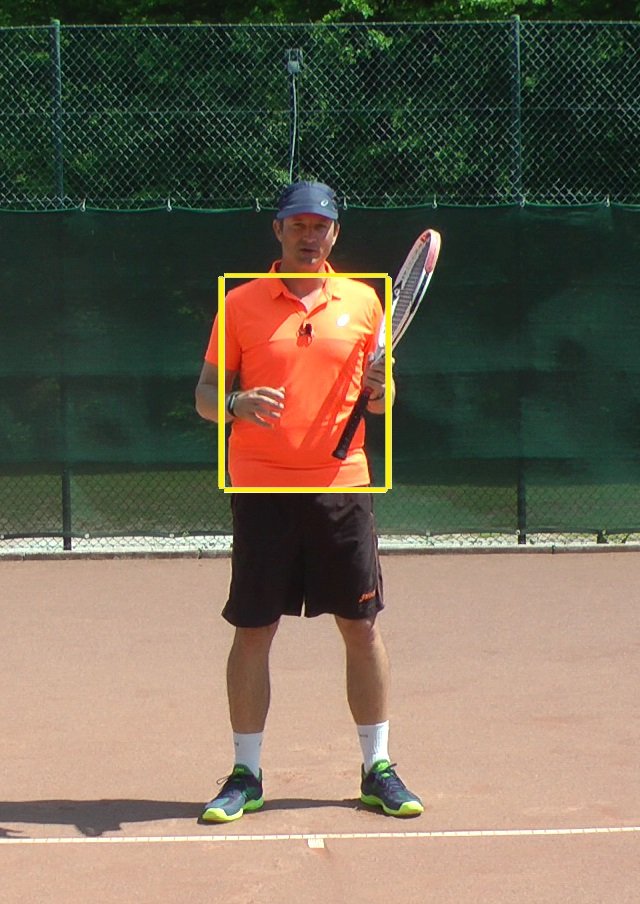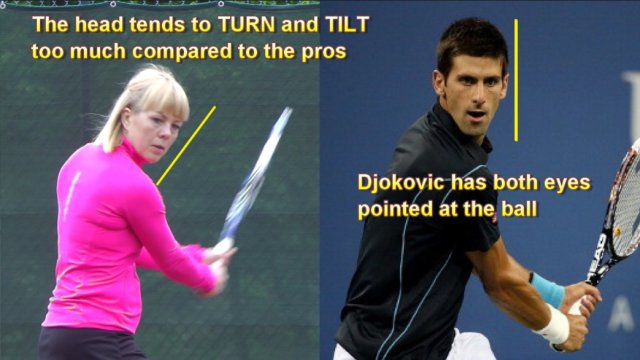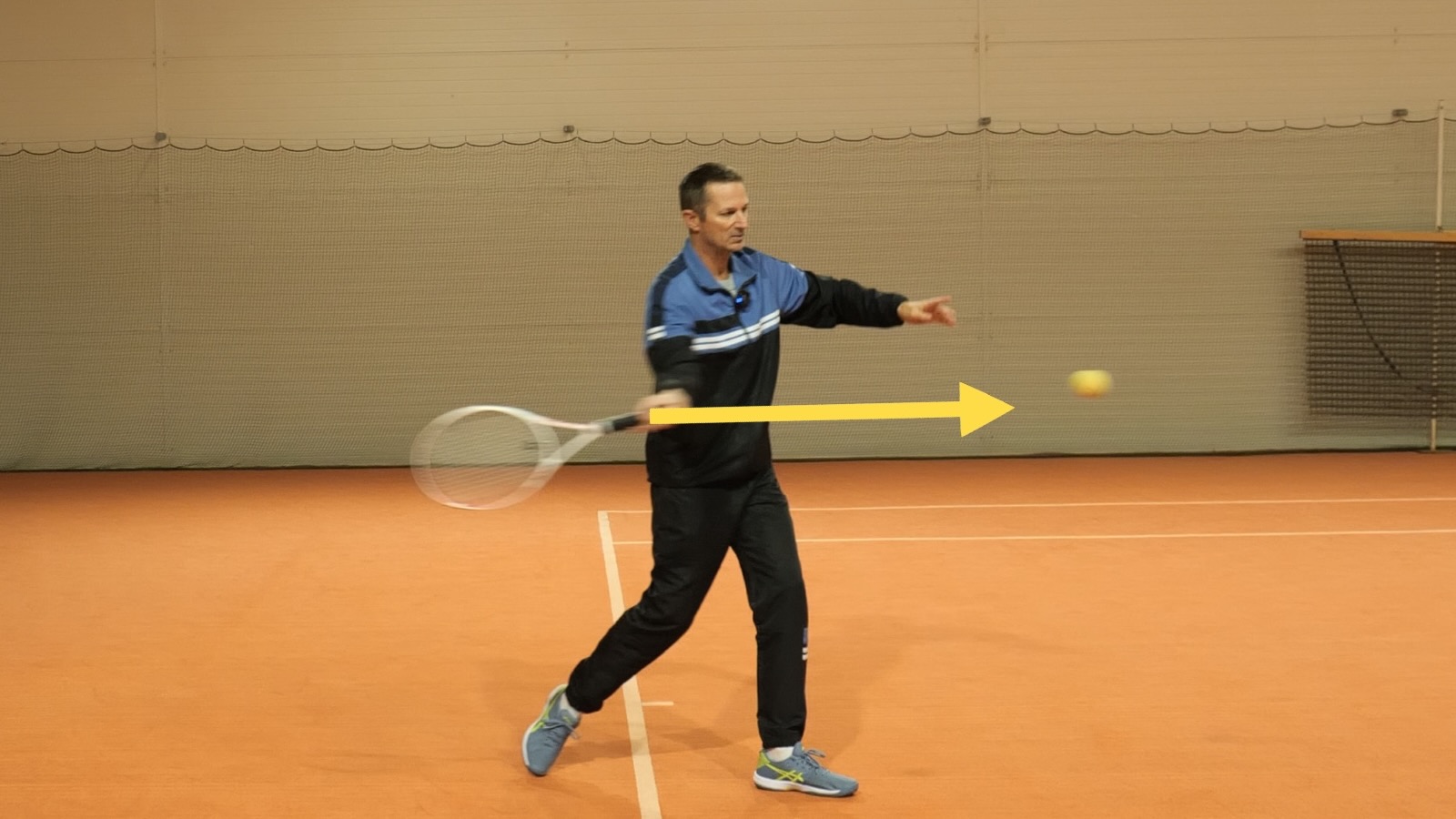You’ve surely heard of the term “unit turn” in online or on-court tennis instruction when your coach was teaching you how to initiate your forehand or backhand stroke.
We use the unit turn tip to stop the player from doing the backswing only with their arm because we want the players also to turn their body to generate more power for the stroke.
While the tennis instruction of executing the unit turn seems very simple at first glance, players still misinterpret it and do it incorrectly.
Two Main Mistakes When Performing The Unit Turn
1. Stepping Back
The first common mistake that players make when executing the unit turn is that they turn their whole body from toe to head.

Mistake #1: Thinking that the "unit" is from toe to head
They imagine that the unit we’re talking about is their whole body, and this results in players stepping back with the right foot (for righthanders).
If you step back as you’re turning your body, you are also transferring your weight backward. That’s not good because in a split second you’ll have to transfer it forward toward the ball.

An example of incorrect unit turn where the player steps back first
This stepping back then robs you of power and time.
Of course, keep in mind that the unit turn I am explaining here is done in easy conditions where we work on the stroke fundamentals which also means you’ll step forward toward the ball and hit it in neutral stance.
If you have to move backward when receiving a deep ball, then you will step back naturally when performing the unit turn.
I am sharing this video article is because I see on a daily basis how players step back and turn their whole body even when they are receiving a nice ball.
So, instead of stepping back with the right leg, you should just pivot on it and then step forward with the left leg toward the ball and execute your forehand.
The same applies to the one- and two-handed backhands, too.
The problem may originate in what the player understands as a unit.
The unit that we should turn is not your whole body from toe to head but just your torso.

This the "unit" you should turn
You should focus on turning the torso from the waist up together with your shoulders and turn that by roughly 90 degrees first. Everything else must follow that.
So, whenever you initiate your stroke whether your forehand or your backhand, you should focus only on turning your torso and not immediately turning your feet, too.

An example of a correct unit turn followed by a step forward
The feet will just follow the upper body whether you step forward, backward or have to move to the side.
2. Turning and Tilting The Head
The second most common mistake when turning the unit is that the rotation of the shoulders tends to pull the head with it, which results in the head turned too much away from the ball.

Mistake #2: The shoulder rotation turns and tilts the head
When the head is turned away from the ball (and tilted), the eyes are not both pointing toward the ball.
And when the eyes are not facing the ball well, we lose the ability to judge depth as we cannot see well in three dimensions.
If the eyes are slanted toward the ball, then one eye sees the ball well but the other doesn’t. As a result, we don’t perceive the ball well as it’s flying toward us, and we will very likely mistime our strokes.
The tilted head also affects our balance since the organ for balance is in our inner ear and every tilt of the head causes the balance system in our brain to engage various muscles to keep us in balance.
A tilted head also prevents good body rotation into the ball because we lose the feeling of the axis of rotation.
We always need to rotate our hips and shoulders throughout the stroke to execute our strokes very efficiently, and a tilted head will often lead to very jerky movements since we’re not rotating well into the shot.
If you look at the pros and how they position their head in relation to their shoulders, you will be amazed to see how flexible they are in their neck. In fact, they can turn their head way more than 90 degrees away from the shoulders.


The best way to practice keeping your head and eyes facing the ball while your body rotates is to stand in front of the mirror and practice this.
Look yourself in the eye and initiate the unit turn by turning your torso by 90 degrees while trying to move your head as little as possible.
You will realize how your head wants to follow your shoulders, so you must try to separate them as much as possible.
Your body needs to turn, but your head must not so that your eyes can both be pointing at the incoming ball.
Only when the ball comes really close to you and you’re about to hit it will you turn your head slightly to the side.
In summary, the fundamental unit turn when we’re receiving an easy ball is done correctly when we turn only the torso to the side and not follow that with the leg stepping or with the head also turning to the side.
That will create the initial coiling in the body that will allow us to release it when we hit the ball and we’ll also be able to judge and time the ball better.
The ball is in your court now: Were you aware of these two little details about the seemingly obvious and simple unit turn part of the strokes, or is this new to you?





Uh oh, I’m definitely step backwards on my unit turn and I have trouble moving my weight forward so that I’m falling back a lot. Also have timing issues. I’d bet that, subconsciously, I’m trying to give myself more time by stepping back but it may be giving me less time! I have a feeling this step back is very ingrained by now – will start working on this.
Thanks
Thanks for the comment, Jon.
Yes, I forgot to mention that the main reason why players step back is to buy themselves more time but as a result they end up hitting off balance.
It is MUCH BETTER to stay where you are and be balance and practice hitting the ball on the rise if necessary.
Of course, you will have some timing problems at first but you MUST persevere and challenge your brain to calculate the timing.
It may not work on day 1 but you have to keep practicing that for weeks and months. You need to start doing that on mini tennis already.
Almost every rec player is moving back already on mini tennis when I warm up with them.
You must hold your ground and practice the timing as then you’ll be stable and balanced.
It’s not easy but it’s the only way to a higher level of play.
Update – been working on this in practice and matches and I’m playing better than ever before. I can very easily see when I’m stepping back and I’m decreasing that mistake more each day. I just took a guy to 5 all who I usually only get one or two games off of. So many of my errors were due to stepping back – especially the return of serve. I’m attacking and making the other guy uncomfortable now. Crazy how you can think you’re doing things right when you’re not. Thanks again.
Tomaz,
Another master class from the legendary Tomaz! I am a rec player who taught the game myself for the most part. My FH is fine with good power and control. For a long time I have been wondering why my 2H-BH is so weak and my BH shots seldom go deep beyond the service line, even when I try very hard. Now you have hit the nail on its head. I can’t wait to put this lesson to practice.
You should receive a honorary PHD from ATP in the field of tennis science . Keep up the good work Tomaz!
Best,
Vivek
Much appreciated, Vivek, glad that you feel you’re on the right track!
Hi Tomaz, this is great advice, it’s just what I have been working on recently. Somehow, I found it easier with by backhand to not step back and to just turn my torso and to keep a forward momentum. I assume it’s a matter of balance and my left leg being the dominant one. Also, with a two-handed backhand, both arms pull the torso.
I find it more difficult to do the same with the forehand, I find myself tilting backwards too often. I am trying to keep my left hand on the racket to properly coil the torso, but any other advice you have would be greatly appreciated.
Hartmut
Hi Hartmut,
Tilting back happens because in your mind’s eye you see a stroke as back –> forward process.
But the stroke is forward –> forward process.
On the forehand for example you go “forward” with your left shoulder first instead of thinking going back with your right arm / shoulder.
Sure, the racket needs to go back but we achieve that by focusing on the “forward” with the left side followed by “forward” with the right side when we swing towards the ball.
So when you realize that it’s forward –> forward, you will have no more tilting back.
Thanks, Tomaz, the forward – forward is a good mental image, I will put it to test on the court!
SO Simple and SO Clear … !!!
Makes me Eager to apply it right away … as I am sure your advice is Highly Effective …!!!
Thank you so much Tomaz, for covering , not only the “what” , but the “why” of the unit turn.
You have given us a gem!
Thank you again.
Linda
Thanks for the feedback, Linda!
Thanks a lot Tomaz,
After your tip, I really see what the problem with the power of my shots and why I feel sometimes that I shot later.
The best of the best advise why I cant hit the correct 4hand or backhand.
I went out and practiced on court and what a difference.
Thanks a million
Yup, my unit turn is incorrect regarding both key points (the unit being just the torso AND both eyes on the ball). I need to prepare earlier for sure because my weight shifts onto my back foot too often.
Making adjustments to different opponents’ style of topspin, slice, etc. is challenging.
The unit turn looks easy and very smooth when done properly. Will work on it!
Excellent video!!
Babs
Hi Babs,
Sure, making adjustments to different balls is difficult and if the unit turn and the whole sequence of how legs need to follow is not right in easy conditions then it will cause even more problems in difficult situations.
So practice in easy conditions first and try to stabilize it there. It will go much easier from then on.
Another great technique to improve my game! Thanks Tomaz, you’re the best! Will use focus on this for tomorrow morning game!! <3 <3
A really profound lesson; what you have presented in such an accessible way can upgrade player’s groundstrokes etc very rapidly. It doesn’t even need a lot of drilling because if they follow what have given it will have such an immediate positive impact that they will not want to prepare for the majority of shots in any other way!
Big big thanks to you.
Hi Thomaz, thanks for the lesson.
I have a question:
When I hit a shot in closed stance:
Does the “unit turn should precede precede the “step into the ball”?
or should the reverse be the case?
Or even doesnt matter?
Because it seems to me that the simple act of stepping into the ball kind of turns your unit in some way, even if it is not in a perfect way.
But yesterday, when I turned my unit before stepping into the ball, I felt an improvement in the speed,spin and accuracy of my shots.
Before that, I “step in to the ball” without conciosuly turning my unit.
I jut did this intentionally turning in open stance.
Hi Rodrigo,
In the learning stage we want to feel the separation between the unit turn and stepping forward because when we turn and don’t step forward yet we will feel coiling (twisting) of the body through the core.
We can then know and feel where to look for power since now we can uncoil.
If you step forward without turning first there is no coiling in the body and you’ll look for power only in the arm.
So for a while you can be conscious about it but eventually you need to stop thinking and start feeling as thinking always takes your attention away from the ball and hence you mistime or misjudge it.
Thanks for the explanation!
Hello Tomaz. Thank you for this lesson! My coach has told me for years that I don’t turn or when I do, I’m turning late. I hope practicing your unit turn lesson will help with this. Do you have other lessons that have helped your students with the timing of their unit turn? I always find your lessons very clear and helpful. Thank you!
Thanks, Sandra!
Sure, I suggest you look at this article on preparing early:
https://www.feeltennis.net/stop-hitting-ball-late/
Love the unit turn with just pointing the shoulder at the incoming ball!
Also you should know, I own that shirt! Love it!
Q
I need to improve on my forehand.. first question ..in forehand do you need to turn hip first before bringing racquet forward.. in other words did the hip rotation bring racquet forward?do we need to move our arm explicitly.. I love your videos
Hi Sagar,
In pro tennis level the hip moves usually much earlier than shoulders but at our level hips and shoulders can move together as one unit.
https://www.youtube.com/watch?v=5LOKkHpFpFU
We let the arm swing at first and then we engage the arm because we aim somewhere so we need to guide the ball towards that target.
Thank you for these words of advice. I have heard so many people talk about a unit turn, but I didn’t understand the fundamentals of it. I definitely thought it was a full body turn. Thank you for clarifying that. It is just the trunk of the body.
Glad that the video was helpful!